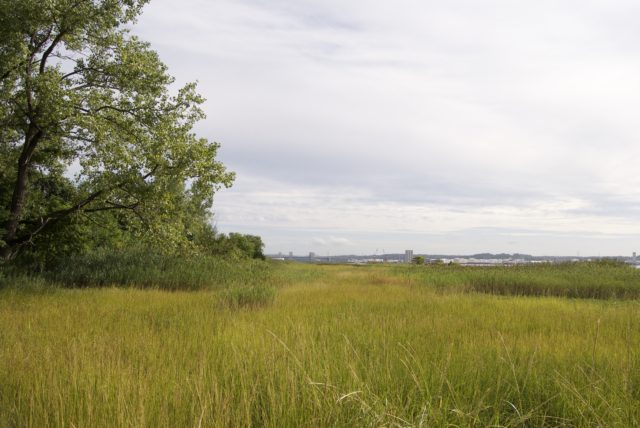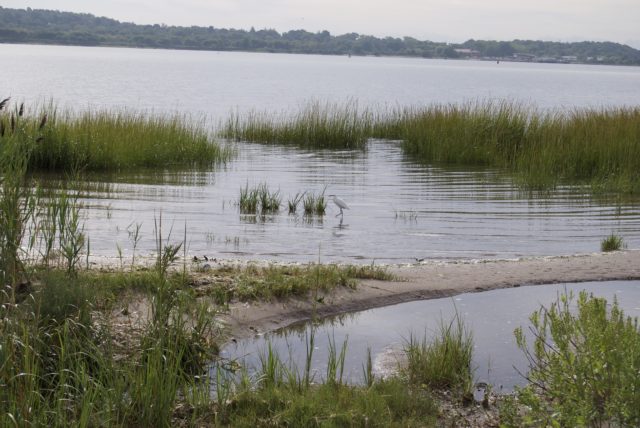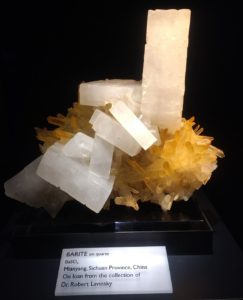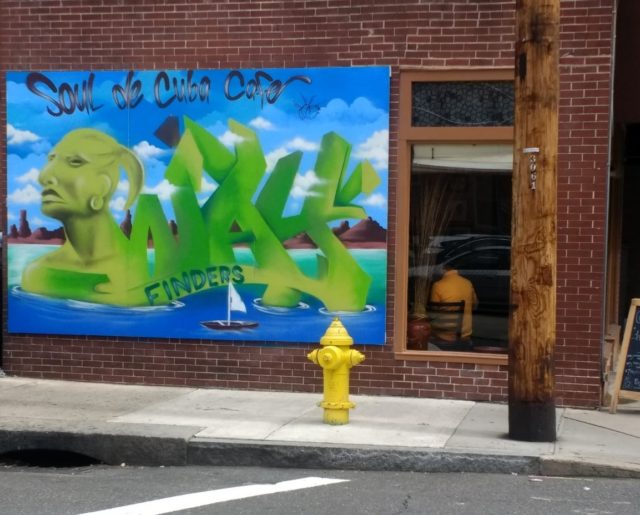I always leave New Haven a little crankier.
There’s always something off in the air, or maybe it’s that there are no easy-to-find public restrooms that are not portapotties. It’s not that you shouldn’t visit New Haven — I keep getting pulled back. It’s a matter of adjusting expectations.
Getting There: New Haven has two train stations, which feels kind of silly since they are not even that far apart. If you want to land where all the action is, take the State Street Station. This is a five-minute walk from the New Haven Green. Union Station makes sense if you’re connecting to another train. Though it’s not actually that far from downtown, the absence of wayfinding combined with absence of human-scale development makes the area seem foreboding.

Long Wharf Nature Preserve: I knew there had to be nature somewhere in New Haven. You can walk here from either train station, but I would suggest renting a bike or riding the bus because it’s kind of soul-sucking, unless you have a friend with you who can distract you from the traffic sewers with witty banter. To be fair, the sidewalks are wide and in good shape the whole distance. The pedestrian signals work. Crosswalks are sometimes present. During rush hour, I found motorists respecting my right to safely cross the roads. But signage is inconsistent and it often feels like you are not going toward anything. It’s maybe twenty minutes from Union Station, yet it feels like an hour because one route puts you along streets with fast-moving traffic, and another is desolate. If you are fine with going even more out of the way, there is a residential route that could be less stressful than walking alongside fast-moving traffic.

The journey is hard to enjoy, but the destination has character. From reading online reviews, it seems that some folks did not find the entrance to the actual nature preserve. You have to be a little curious and walk up an unpaved path to access the fifteen acres. The preserve is maintained by New Haven Land Trust, and you’ll see their logo along the path. Informative signs (my favorite!) line the trails, so you can learn how this preserve was created and what kinds of creatures you should expect to see. There’s sand, rabbits, horsehoe crabs. There is not much physical challenge to the walk — it’s not a mountainous hike. What’s not to like about that?
There’s one little thing: the sound. I don’t normally advise going into natural areas with earbuds in because it takes away from the experience, but here, even noise-cancelling headphones without music would help muffle the cacophony that is I-95.

Because it’s such a pain to get over here, you might as well walk the paved path that goes by all the food trucks and check out the pier that has informational signs about the Amistad. The path will take you right by a seafood restaurant, if you want something fancier than food truck fare. A bicycle and pedestrian path is separated from motorized traffic by bollards, which in my opinion, could be placed much closer together, but what do I know…Hartford tried bollards for a minute before removing them. Exploring on foot affords the opportunity to think on how even places that are lightyears ahead of Hartford still have so much opportunity to get better.

 Yale Peabody Museum of Natural History: If you can’t quite make it to the natural history museums in New York or DC, this is worth a visit.
Yale Peabody Museum of Natural History: If you can’t quite make it to the natural history museums in New York or DC, this is worth a visit.
The rooms filled with taxidermied birds (found here in Connecticut) taught me how many I had misidentified over the years. These were in nice condition, I should mention, as that is not always the case with dead, stuffed critters. Over the years I’ve seen specimens that were the stuff of nightmares, so I am always relieved when I walk through halls of dead things that don’t give me the creeps.
The gems and minerals were another highlight, with labels explaining where in the world each item was found. I will never not want just a bit more information about how materials are sourced, however, and I never have seen an explanation here or anywhere about how mining/excavation impacts the environment.
 The North American and Southern New England dioramas were well done. I overheard confusion from young kids who were scared by some of the animals, so I guess they looked alive enough. I don’t envy whoever has the task of constantly wiping hand and mouth smudges off the glass.
The North American and Southern New England dioramas were well done. I overheard confusion from young kids who were scared by some of the animals, so I guess they looked alive enough. I don’t envy whoever has the task of constantly wiping hand and mouth smudges off the glass.
The dinosaur room…well, that’s obviously a crowd-pleaser. It’s also another noisy spot, so bring your earbuds if you don’t enjoy listening to dozens of kids freaking out over Deinonychus. Don’t miss the petrified wood!
Discounts: $6 off each admission with a Hartford Public Library pass, or use a CTrides coupon to get $5 off admission. I mention both because maybe you didn’t plan enough in advance for the library-issued museum pass, but you took the train.

International Festival of Arts & Ideas: For several decades now, a mix of performances, walking and cycling tours, lectures, and more in June. Past performers have included Debo Band, Fendika, Lucinda Williams, and Carolina Chocolate Drops. Most of the events are free.

 Eating: You could pack your own lunch, but if you’ve got money for it, this is one of the things that doesn’t make me irritated at New Haven. In the downtown area, you don’t have to put in any effort to find food, whether that means Chipotle or something local. Here are a few suggestions:
Eating: You could pack your own lunch, but if you’ve got money for it, this is one of the things that doesn’t make me irritated at New Haven. In the downtown area, you don’t have to put in any effort to find food, whether that means Chipotle or something local. Here are a few suggestions:
- Claire’s Corner Copia: This was a vegetarian restaurant before plant-based diets were cool. (1000 Chapel)
- Atticus Bookstore Cafe: Please don’t be that person who only comes in here to eat. They sell books and vinyl. Fill your stomach and your soul. Their chocolate croissants are buttery. Skip the chain cafes and come here for a latte or chai instead, not because it’s “supporting local,” but because they know how to do it. Note: their restrooms say that they are for patrons only, but Atticus does not lock them, which gives them another point still. (1082 Chapel)
- BAR: If you like garlic, potatoes, and pizza, come here and merge all three. (254 Crown Street)
- Mamoun’s: falafel (85 Howe)
- Elm City Market — a medium-large grocery that is not a chain, right in downtown, across from the commuter train station.

Wandering: Yes, parts of New Haven are filled with people out on the sidewalks, but that is not all streets. That is a thing to remember. It’s possible, during business hours on a weekday, to walk for ten minutes without seeing another person on foot.

New Haven is where you can stumble over vintage stores, bike shops, and cafes without even trying. You can effortlessly come upon several bookstores. It’s where you can hear bad poetry recited in lieu of direct panhandling, and where you can be cornered in a pocket park late at night by someone who wants to sing you a few songs from the 1960s; her voice should have her on a stage and she never actually asks for money.

You can walk by Yale’s gorgeous buildings or happen upon the Grove Street Cemetery.
Or, you can, from the train station, watch a parking lot attendant disarm a man wielding a baseball bat; the man whose shirt is ripped halfway off takes keys and a wallet from the attendant’s booth and tosses both over the side of the lot, down to the train platform and tracks below. A woman takes video of this at close range. The police get the guy in cuffs. Before your train arrives, you see three others roll over the tracks where the wallet’s contents landed. It could all have been worse, but this is not a good day for anyone involved.
You can see the impact of drug addiction on dozens of people, mostly men, out in the open of the green. . . which is not unlike what you see in Hartford’s Barnard Park, but is also not a scene on view in other parts of the country. It gives you something to think about. If the opioid problem is widespread why is it hidden in other regions, while here, it’s right up in our faces?

 While wandering, you will have the chance to ask: “Is the multimodal transportation infrastructure really better in New Haven?” For the uninitiated, there’s a bit of a “New Haven is a Transit Eden” cult. Better does not mean perfect.
While wandering, you will have the chance to ask: “Is the multimodal transportation infrastructure really better in New Haven?” For the uninitiated, there’s a bit of a “New Haven is a Transit Eden” cult. Better does not mean perfect.
When they installed the contra-flow bike lane on High Streetin 2016, I was admittedly impressed. But on 75% of my visits since, the lane has been rendered useless. Despite the signs that very clearly say not to park in the bike lane, and despite the lane itself visually conveying that it is not a space for cars, there are still people who park in it. Naturally, I tweeted out a pic of a violator following my most recent visit, asking what New Haven is doing in terms of enforcement. I got a response with a phone number to call for reporting such things, along with a link to an article that soothed and enraged at the same time. That must be New Haven’s superpower: the ability to inspire contrasting emotions at the same time. The article (go read it) explains that New Haven does fine offenders — yay — but this does not seem to be discouraging bad behavior. Yale paid $85,000 in 2018 for parking violations. These are not fines for simply letting a meter run out, y’all. This is blatant, irresponsible and rude behavior like parking across sidewalks, and yes, in bike lanes. They endanger cyclists’ and pedestrians’ safety, but at the end of the day, throw money at the problem. One wonders if there can be special policies applied for top offenders, like instant towing or tripled fines. That’s probably a legal issue, but a broad can dream.

From the way transit nerds bow at the altar of New Haven, I always come here expecting more, and leave disappointed that there are as few bike lanes as there are. On my walk back to downtown from Long Wharf, I considered renting a bike. I could see a somewhat bollard-protected lane, yet I had no way of knowing from signs on site if this trail continued all the way back like this, or if it suddenly ended. Wayfinding signs, in New Haven, continue to be inconsistent. What made the decision on the bike rental for me was the missing seat on the bike I was looking at. I’m willing to go a mile without a helmet if the bike lane is truly separate, but no helmet and no seat would be a deal breaker.

I can’t overstate how strange it is to see so few wayfinding signs that could help cyclists and people on foot navigate from the walkable downtown area to the walkable wharf, given that the space in between largely feels uninviting due to oversized buildings, oversized surface parking lots, superblocks, and the ever-divisiveness of the highway. The signs popped up when I was already near the destination, as in, I could look down a block and see what was obviously the wharf park, or I had left the land of ginormous parking lots and could tell I was more-or-less back in downtown. How many people even realize they can walk to IKEA from Union Station?

But then, there are intersections where the crosswalks have been widened. A few years ago, I and others on the Complete Streets Task Force asked the City of Hartford if we could have specially painted crosswalks in key places, like near elementary schools. We were told it would be impossible. Meanwhile, New Britain, Simsbury, and New Haven have all done this. New Haven also has flashing pedestrian crossing signs installed in numerous places. These are ones where you hit a button before crossing and signs light up to alert motorists, just in case they somehow are not looking in front of them or do not see the painted crosswalk. As of publication, to my knowledge, Hartford only has one of these; it’s installed on Market Street by Candlewood Suites.

Although New Haven’s bus system is not nearly as extensive as Hartford’s, they have decorated a few of their bus shelters. The artwork on several faces the street, where motorists stuck in traffic can perhaps absorb the message that “buses and other forms of sustainable transportation help protect” our natural resources. I’d like to see a little more of that up here, and a little less of the bus wraps that feature vodka. I should note that the decorated shelters are also done right — they are not painted opaque, making it hard or impossible for people inside of them to see what bus is approaching.

Wandering New Haven, you’ll see bike racks loaded with bicycles. At a glance, this has the appearance of a smart, sustainable community. Look closer. How many of those bikes have been sitting there for months? Flat tires, missing parts, bent wheels. Every so often these neglected wheels are liberated and given to the Bradley Street Bicycle Co-op for its recycling program. These get processed back into the system. It’s not all bad. But a casual observation gives the impression that almost twice as many people are cycling in some areas than actually are.

Which raises this question — what does it mean when people can simply leave bicycles like this? It means money. And that is what stimulates much of my crankiness about New Haven. With the presence of a certain college, far more money is flowing through the city than what we see in Hartford; therefore, I have much higher expectations about what a place can do when there is funding that can potentially be tapped into.

Still, New Haven has the Masked Maniax, who I have seen in action.
Like I said, it’s complicated.
New Haven: It’s Complicated
I always leave New Haven a little crankier.
There’s always something off in the air, or maybe it’s that there are no easy-to-find public restrooms that are not portapotties. It’s not that you shouldn’t visit New Haven — I keep getting pulled back. It’s a matter of adjusting expectations.
Getting There: New Haven has two train stations, which feels kind of silly since they are not even that far apart. If you want to land where all the action is, take the State Street Station. This is a five-minute walk from the New Haven Green. Union Station makes sense if you’re connecting to another train. Though it’s not actually that far from downtown, the absence of wayfinding combined with absence of human-scale development makes the area seem foreboding.
Long Wharf Nature Preserve: I knew there had to be nature somewhere in New Haven. You can walk here from either train station, but I would suggest renting a bike or riding the bus because it’s kind of soul-sucking, unless you have a friend with you who can distract you from the traffic sewers with witty banter. To be fair, the sidewalks are wide and in good shape the whole distance. The pedestrian signals work. Crosswalks are sometimes present. During rush hour, I found motorists respecting my right to safely cross the roads. But signage is inconsistent and it often feels like you are not going toward anything. It’s maybe twenty minutes from Union Station, yet it feels like an hour because one route puts you along streets with fast-moving traffic, and another is desolate. If you are fine with going even more out of the way, there is a residential route that could be less stressful than walking alongside fast-moving traffic.
The journey is hard to enjoy, but the destination has character. From reading online reviews, it seems that some folks did not find the entrance to the actual nature preserve. You have to be a little curious and walk up an unpaved path to access the fifteen acres. The preserve is maintained by New Haven Land Trust, and you’ll see their logo along the path. Informative signs (my favorite!) line the trails, so you can learn how this preserve was created and what kinds of creatures you should expect to see. There’s sand, rabbits, horsehoe crabs. There is not much physical challenge to the walk — it’s not a mountainous hike. What’s not to like about that?
There’s one little thing: the sound. I don’t normally advise going into natural areas with earbuds in because it takes away from the experience, but here, even noise-cancelling headphones without music would help muffle the cacophony that is I-95.
Because it’s such a pain to get over here, you might as well walk the paved path that goes by all the food trucks and check out the pier that has informational signs about the Amistad. The path will take you right by a seafood restaurant, if you want something fancier than food truck fare. A bicycle and pedestrian path is separated from motorized traffic by bollards, which in my opinion, could be placed much closer together, but what do I know…Hartford tried bollards for a minute before removing them. Exploring on foot affords the opportunity to think on how even places that are lightyears ahead of Hartford still have so much opportunity to get better.
The rooms filled with taxidermied birds (found here in Connecticut) taught me how many I had misidentified over the years. These were in nice condition, I should mention, as that is not always the case with dead, stuffed critters. Over the years I’ve seen specimens that were the stuff of nightmares, so I am always relieved when I walk through halls of dead things that don’t give me the creeps.
The gems and minerals were another highlight, with labels explaining where in the world each item was found. I will never not want just a bit more information about how materials are sourced, however, and I never have seen an explanation here or anywhere about how mining/excavation impacts the environment.
The dinosaur room…well, that’s obviously a crowd-pleaser. It’s also another noisy spot, so bring your earbuds if you don’t enjoy listening to dozens of kids freaking out over Deinonychus. Don’t miss the petrified wood!
Discounts: $6 off each admission with a Hartford Public Library pass, or use a CTrides coupon to get $5 off admission. I mention both because maybe you didn’t plan enough in advance for the library-issued museum pass, but you took the train.
International Festival of Arts & Ideas: For several decades now, a mix of performances, walking and cycling tours, lectures, and more in June. Past performers have included Debo Band, Fendika, Lucinda Williams, and Carolina Chocolate Drops. Most of the events are free.
Wandering: Yes, parts of New Haven are filled with people out on the sidewalks, but that is not all streets. That is a thing to remember. It’s possible, during business hours on a weekday, to walk for ten minutes without seeing another person on foot.
New Haven is where you can stumble over vintage stores, bike shops, and cafes without even trying. You can effortlessly come upon several bookstores. It’s where you can hear bad poetry recited in lieu of direct panhandling, and where you can be cornered in a pocket park late at night by someone who wants to sing you a few songs from the 1960s; her voice should have her on a stage and she never actually asks for money.
You can walk by Yale’s gorgeous buildings or happen upon the Grove Street Cemetery.
Or, you can, from the train station, watch a parking lot attendant disarm a man wielding a baseball bat; the man whose shirt is ripped halfway off takes keys and a wallet from the attendant’s booth and tosses both over the side of the lot, down to the train platform and tracks below. A woman takes video of this at close range. The police get the guy in cuffs. Before your train arrives, you see three others roll over the tracks where the wallet’s contents landed. It could all have been worse, but this is not a good day for anyone involved.
You can see the impact of drug addiction on dozens of people, mostly men, out in the open of the green. . . which is not unlike what you see in Hartford’s Barnard Park, but is also not a scene on view in other parts of the country. It gives you something to think about. If the opioid problem is widespread why is it hidden in other regions, while here, it’s right up in our faces?
When they installed the contra-flow bike lane on High Streetin 2016, I was admittedly impressed. But on 75% of my visits since, the lane has been rendered useless. Despite the signs that very clearly say not to park in the bike lane, and despite the lane itself visually conveying that it is not a space for cars, there are still people who park in it. Naturally, I tweeted out a pic of a violator following my most recent visit, asking what New Haven is doing in terms of enforcement. I got a response with a phone number to call for reporting such things, along with a link to an article that soothed and enraged at the same time. That must be New Haven’s superpower: the ability to inspire contrasting emotions at the same time. The article (go read it) explains that New Haven does fine offenders — yay — but this does not seem to be discouraging bad behavior. Yale paid $85,000 in 2018 for parking violations. These are not fines for simply letting a meter run out, y’all. This is blatant, irresponsible and rude behavior like parking across sidewalks, and yes, in bike lanes. They endanger cyclists’ and pedestrians’ safety, but at the end of the day, throw money at the problem. One wonders if there can be special policies applied for top offenders, like instant towing or tripled fines. That’s probably a legal issue, but a broad can dream.
From the way transit nerds bow at the altar of New Haven, I always come here expecting more, and leave disappointed that there are as few bike lanes as there are. On my walk back to downtown from Long Wharf, I considered renting a bike. I could see a somewhat bollard-protected lane, yet I had no way of knowing from signs on site if this trail continued all the way back like this, or if it suddenly ended. Wayfinding signs, in New Haven, continue to be inconsistent. What made the decision on the bike rental for me was the missing seat on the bike I was looking at. I’m willing to go a mile without a helmet if the bike lane is truly separate, but no helmet and no seat would be a deal breaker.
I can’t overstate how strange it is to see so few wayfinding signs that could help cyclists and people on foot navigate from the walkable downtown area to the walkable wharf, given that the space in between largely feels uninviting due to oversized buildings, oversized surface parking lots, superblocks, and the ever-divisiveness of the highway. The signs popped up when I was already near the destination, as in, I could look down a block and see what was obviously the wharf park, or I had left the land of ginormous parking lots and could tell I was more-or-less back in downtown. How many people even realize they can walk to IKEA from Union Station?
But then, there are intersections where the crosswalks have been widened. A few years ago, I and others on the Complete Streets Task Force asked the City of Hartford if we could have specially painted crosswalks in key places, like near elementary schools. We were told it would be impossible. Meanwhile, New Britain, Simsbury, and New Haven have all done this. New Haven also has flashing pedestrian crossing signs installed in numerous places. These are ones where you hit a button before crossing and signs light up to alert motorists, just in case they somehow are not looking in front of them or do not see the painted crosswalk. As of publication, to my knowledge, Hartford only has one of these; it’s installed on Market Street by Candlewood Suites.
Although New Haven’s bus system is not nearly as extensive as Hartford’s, they have decorated a few of their bus shelters. The artwork on several faces the street, where motorists stuck in traffic can perhaps absorb the message that “buses and other forms of sustainable transportation help protect” our natural resources. I’d like to see a little more of that up here, and a little less of the bus wraps that feature vodka. I should note that the decorated shelters are also done right — they are not painted opaque, making it hard or impossible for people inside of them to see what bus is approaching.
Wandering New Haven, you’ll see bike racks loaded with bicycles. At a glance, this has the appearance of a smart, sustainable community. Look closer. How many of those bikes have been sitting there for months? Flat tires, missing parts, bent wheels. Every so often these neglected wheels are liberated and given to the Bradley Street Bicycle Co-op for its recycling program. These get processed back into the system. It’s not all bad. But a casual observation gives the impression that almost twice as many people are cycling in some areas than actually are.
Which raises this question — what does it mean when people can simply leave bicycles like this? It means money. And that is what stimulates much of my crankiness about New Haven. With the presence of a certain college, far more money is flowing through the city than what we see in Hartford; therefore, I have much higher expectations about what a place can do when there is funding that can potentially be tapped into.
Still, New Haven has the Masked Maniax, who I have seen in action.
Like I said, it’s complicated.
Related Posts
Place This Place
47th Annual Greater Hartford St. Patrick’s Day Parade
Look: Farmers’ Market